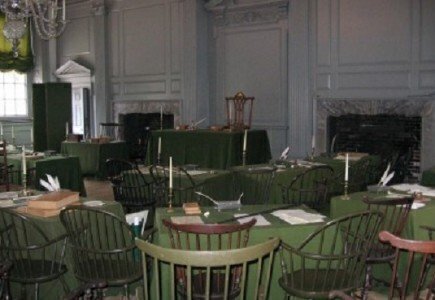This Thursday marks the 100th anniversary of the act that established the National Park Service. And if you have the time to travel, here’s a list of NPS sites and National Landmarks you can visit related to the great events and cases that have helped defined our Constitution.

While many of the buildings related to events are long gone, others have been preserved or remain in use. Here are a few suggestions we have if you feel the urge to hit the road.
New York City has several interesting landmarks with constitutional ties. Your first stop will likely be the Hamilton Grange National Memorial. The house was moved to St. Nicholas Park in 2008 and reopened on Constitution Day in 2011. It is believed to be the only house that Alexander Hamilton owned. The Park Service has operated the Grange since 1962. Another interesting landmark is the Pierpont Morgan Library on 36th Street. J.P. Morgan was a key player in the Supreme Court decision of Northern Securities Company et al. v. United States (1904), the first case to uphold the Sherman Anti-Trust Act.
A trip down to Philadelphia will take you to one obvious location and another lesser-known gem. Just north of Philadelphia in Bensalem, Pa., is Andalusia, the country home of Nicholas Biddle, President of the Second Bank of the United States. Biddle’s bank was the center of contention in McCulloch v. Maryland (1819), the seminal Court decision about federal and state powers. Then when you make a stop at Independence National Historical Park, you can tour Independence Hall, where both the Constitution and Declaration of Independence were crafted, and also see the Old Supreme Court building, Congress Hall, the first two Banks of the United States, and the Liberty Bell.
A detour west of Philadelphia will take you to Gettysburg National Military Park, which is part of the National Park System. We all know about the significance of the great Civil War battle that was fought there in July 1863, but did you know that the battlefield itself was the subject of a major Supreme Court decision? In 1896, the Court ruled in United States v. Gettysburg Electric Railway Company that the preservation of nationally important historic sites is a legitimate purpose of the United States government.
If you decide to head south from Gettysburg, Washington, D.C., has plenty of historical and constitutional landmarks. At last count, there were at least 74 National Historic Landmarks in the District of Columbia alone. One you don’t want to miss is the current Supreme Court Building, which was opened in 1935 and designed by Cass Gilbert. Another interesting building you can walk by is the current Burmese ambassador’s residence in the Kalorama district: It is the former house of Chief Justice Charles Evans Hughes.
Down south below the federal district, you’ll find a significant house museum you can tour: Chief Justice John Marshall’s home in Richmond, Virginia. The house museum has operated since 1913 and it has a large collection of objects associated with Marshall. Another National Landmark in Richmond is the Wickham-Valentine House, which is open for guided tours. John Wickham successfully defended Aaron Burr when he was charged with treason in 1807.
If you head west from Pennsylvania, neighboring Ohio has some interesting constitutional landmarks. For example, in Youngstown, the old Stambaugh Building designed by Albert Kahn can be seen as you walk or drive by Federal Plaza. The building may soon become a hotel, but it was the former home of the Youngstown Sheet and Tube Company, the subject of a very big Supreme Court decision that helped defined presidential powers.
A trip to Mentor, Ohio will take you to the James Garfield National Historic Site, the home of the 20th President. Did you know that Garfield also argued a significant Supreme Court case, Ex parte Milligan? And no trip to Ohio would be complete without a journey to the William Howard Taft National Historic Site in Cincinnati.
Other constitutional landmarks to consider include the Tennessee State Capitol building in Nashville, Tennessee, designed by William Strickland. The Tennessee state legislature was the subject of the landmark Baker v. Carr case in 1962, which found that Federal Courts can decide the constitutionality of apportionment of state legislatures.
The Sumner Elementary School in Topeka, Kansas, is a National Landmark but also a privately owned building. The dispute over segregation at the school was part of the Court’s decision in Brown v. Board of Education, which held that segregation in public schools was unconstitutional.
In Georgia, the New Echota Historic Site is a state park and a National Historical Landmark. It was the first capital of the Cherokee Nation, which was the subject of two landmark decisions by Chief Justice John Marshall in the 1830s.
And the Jefferson National Expansion Memorial in St. Louis not only has the famed Gateway Arch, but it has the Old Courthouse, the location of the first two Dred Scott trials. Visitors can learn about the Dred Scott case and see restored 19th-century courtrooms.






